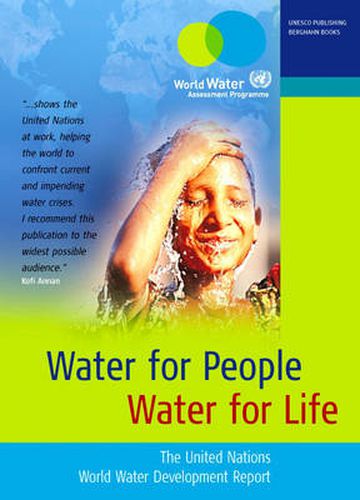Readings Newsletter
Become a Readings Member to make your shopping experience even easier.
Sign in or sign up for free!
You’re not far away from qualifying for FREE standard shipping within Australia
You’ve qualified for FREE standard shipping within Australia
The cart is loading…






The world’s freshwater resources are coming under growing pressure through such environmental hazards as human waste, urbanization, industrialization, and pesticides. The problems are exacerbated through drought in many parts of the world. The improvement of the water quality itself and access to it have been major concerns for politicians and development agencies for over a decade. First officially formulated at the Rio Earth Summit of 1992, they have been restated or expanded since then.
The UN Millennium Declaration of 2000 transformed general guidelines into specific targets. The international community pledged to halve by 2015 the proportion of people who are unable to reach, or to afford, safe drinking water and to stop the unsustainable exploitation of water resources, by developing water management strategies at the regional, national and local levels, which promote both equitable access and adequate supplies. Thus, ten years after Rio it is time to take stock.
Based on the collective inputs of 23 United Nations agencies and convention secretariats, this Report offers a global overview of the state of the world’s freshwater resources. It is part of an on-going assessment process to develop policies and help with their implementation as well as to measure any progress towards achieving sustainable use of water resources.
Generously illustrated with more than 25 full-color global maps and numerous figures, the report reviews progress and trends and presents seven pilot case studies of river basins representing various social, economic and environmental settings: Lake Titicaca (Bolivia, Peru); Senegal river basin (Senegal, Mali, Mauritania, Guinea); Seine Normandy (France); Lake Peipsi/Chudskoe (Estonia, Russia); Ruhuna basin (Sri Lanka); Greater Tokyo region (Japan); and Chao Phraya (Thailand). It assesses progress in 11 challenge areas, including health, food, environment, shared water resources, cities, industry, energy, risk management, knowledge, valuing water and governance. Proposing methodologies and indicators for measuring sustainability, it lays the foundations for regular, system-wide monitoring and reporting by the UN, together with the development of standardized methodologies and data.
With its comprehensive maps, glossary, references and coverage of a broad range of themes and examples of real-world river basins, the UN World Water Development Report will no doubt prove to be a most valuable reference work.
Visit the United Nation’s Water Portal for more information on the report and on the International Year of Freshwater 2003.
$9.00 standard shipping within Australia
FREE standard shipping within Australia for orders over $100.00
Express & International shipping calculated at checkout
The world’s freshwater resources are coming under growing pressure through such environmental hazards as human waste, urbanization, industrialization, and pesticides. The problems are exacerbated through drought in many parts of the world. The improvement of the water quality itself and access to it have been major concerns for politicians and development agencies for over a decade. First officially formulated at the Rio Earth Summit of 1992, they have been restated or expanded since then.
The UN Millennium Declaration of 2000 transformed general guidelines into specific targets. The international community pledged to halve by 2015 the proportion of people who are unable to reach, or to afford, safe drinking water and to stop the unsustainable exploitation of water resources, by developing water management strategies at the regional, national and local levels, which promote both equitable access and adequate supplies. Thus, ten years after Rio it is time to take stock.
Based on the collective inputs of 23 United Nations agencies and convention secretariats, this Report offers a global overview of the state of the world’s freshwater resources. It is part of an on-going assessment process to develop policies and help with their implementation as well as to measure any progress towards achieving sustainable use of water resources.
Generously illustrated with more than 25 full-color global maps and numerous figures, the report reviews progress and trends and presents seven pilot case studies of river basins representing various social, economic and environmental settings: Lake Titicaca (Bolivia, Peru); Senegal river basin (Senegal, Mali, Mauritania, Guinea); Seine Normandy (France); Lake Peipsi/Chudskoe (Estonia, Russia); Ruhuna basin (Sri Lanka); Greater Tokyo region (Japan); and Chao Phraya (Thailand). It assesses progress in 11 challenge areas, including health, food, environment, shared water resources, cities, industry, energy, risk management, knowledge, valuing water and governance. Proposing methodologies and indicators for measuring sustainability, it lays the foundations for regular, system-wide monitoring and reporting by the UN, together with the development of standardized methodologies and data.
With its comprehensive maps, glossary, references and coverage of a broad range of themes and examples of real-world river basins, the UN World Water Development Report will no doubt prove to be a most valuable reference work.
Visit the United Nation’s Water Portal for more information on the report and on the International Year of Freshwater 2003.